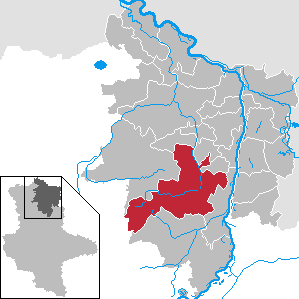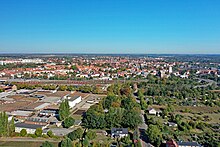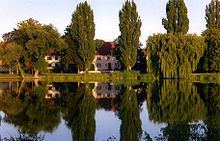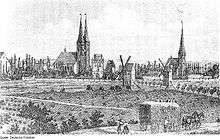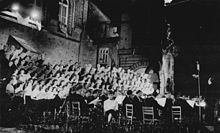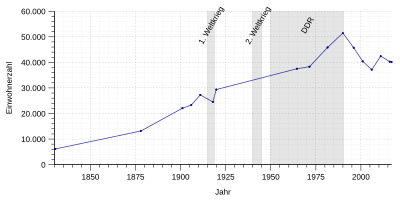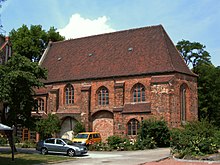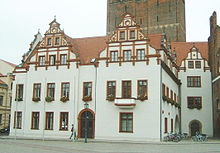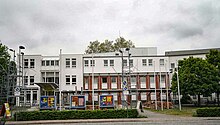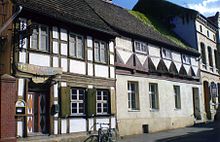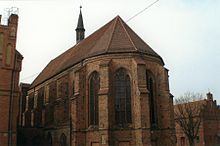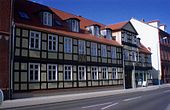Stendal
| coat of arms | Germany map | |
|---|---|---|

|
Coordinates: 52 ° 36 ' N , 11 ° 52' E |
|
| Basic data | ||
| State : | Saxony-Anhalt | |
| County : | Stendal | |
| Height : | 32 m above sea level NHN | |
| Area : | 268.02 km 2 | |
| Residents: | 39,103 (Dec. 31, 2019) | |
| Population density : | 146 inhabitants per km 2 | |
| Postal code : | 39576 | |
| Primaries : | 03931, 039325, 039328, 039329, 039361 | |
| License plate : | SDL, HV, OBG | |
| Community key : | 15 0 90 535 | |
| LOCODE : | DE STQ | |
| NUTS : | DEE0D | |
| City structure: | 36 districts | |
City administration address : |
Markt 1 39576 Hanseatic City of Stendal |
|
| Website : | ||
| Lord Mayor : | Klaus Schmotz ( CDU ) | |
| Location of the district town of Stendal in the district of the same name |
||
The Hanseatic city of Stendal is the district town of the district of Stendal and, with around 40,000 inhabitants, the largest city and traffic junction in the Altmark in Saxony-Anhalt .
geography
Stendal is not far west of the Elbe in the south-eastern Altmark . Berlin is around 120 kilometers away, Hanover around 150 kilometers. Leipzig is around 160 kilometers and Hamburg around 180 kilometers away. Stendal is about 55 kilometers north of Magdeburg on the Wolfsburg- Berlin axis .
climate
The annual mean precipitation is 493 mm and is therefore relatively low. Lower values are registered at only 2% of the German Weather Service's measuring stations . The driest month is February, with the most rainfall in June. In June there is twice more rainfall than in February. Precipitation varies only minimally and is extremely evenly distributed over the year. Lower seasonal fluctuations are recorded at only 3% of the measuring stations.
Outline of the city
The village of Stendal (core city) consists of the following districts :
|
|
Places to live: Haferbreite, Lindenhof, Tannensiedlung
The unified community of Stendal consists of another 18 localities , 30 districts and 5 residential spaces .
|
|
history
Middle Ages to the 20th century
Archaeologists have discovered a wooden box fountain in Rathenower Straße , which dates to the year 889 and indicates a suburban settlement.
A document allegedly issued by Emperor Heinrich II in 1022, in which the village of Steinedal appears among the possessions of the Michaeliskloster in Hildesheim , is a forgery from the 12th century. The original document from Heinrich II. (No. 479) does not contain this place name. The Brandenburg Margrave Albrecht the Bear founded a market in his village of Stendale around 1160 and granted the town Magdeburg rights . Excavations have confirmed that the construction on land in the area of the market south of the "Old Village" in Stendal began around 1160.
In the 12th and 13th centuries there was an approximately 60-meter-long brick department store on the market square , which is considered the oldest department store and one of the largest and most important north of the Alps.
The parish of St. Jacobi was founded in the 12th century . The construction of a Franciscan monastery at Mönchskirchhof began in 1230. In the 13th century the Stendal Seafarers' Guild was formed, which traded with its own ships in the Baltic and North Sea region. The oldest written mention of the merchant church of St. Marien comes from the year 1283. Around 1300 Stendal received city walls, at the same time the Tangermünder Tor was built. The field stone substructure is still preserved today as the foundation of a newer gate structure. In 1338 a Latin school was built on Brüderstraße, which later became a grammar school, whose famous pupil in the 18th century was the later archaeologist Johann Joachim Winckelmann . He attended high school from 1726 to 1736.
There is evidence that Stendal belonged to the Hanseatic League from 1358 to 1518 . Alongside Brandenburg an der Havel , Stendal was the oldest mint in the Mark Brandenburg . In the margraviate of Brandenburg, several cities, including Stendal, paid the margrave a one-time settlement and were given the right to mint the so-called Eternal Penny .
In the 14th century, the refectory of the Franciscan monastery was built at Mönchskirchhof, which today houses the city library . At the place where the Stendal Castle still stood in 1215, construction of the Stendal Cathedral began in 1423 . In 1440 the Uenglinger Tor was built. In the 15th century the town hall was built in various stages with a Gewandhaus, choir and side wing. The St. Catherine's Monastery (foundation of Elector Friedrich II for Augustinian women , today Altmärkisches Museum and Musikforum) was built in 1456. In 1462 the carved wall that is still preserved was completed in the town hall festival hall.
From 1488 Joachim Westfal, the first printer of the Mark Brandenburg, worked in Stendal. In the same year, the citizens of Stendal revolted against the beer tax . In 1502, the Brandenburg Elector Joachim I in Stendal married Elisabeth (1485–1555), the daughter of the Danish King Johann I. In 1518, Stendal left the Hanseatic League together with Berlin , Brandenburg, Frankfurt (Oder) and Salzwedel . The Stendaler Roland was erected in 1525. In 1539, through the Reformation, Lutheran teaching became an official religion in the Altmark. Luther's pupil and colleague Konrad Cordatus was the first Lutheran superintendent on site from 1540 . In 1535, 1540 and 1549 Achim von Zehmen , married to Margarete von Lüderitz, was named mayor of Stendal. In 1682 1,205 people (including 537 children) died of the plague in the city . From 1771 to 1830 the city fortifications were partially demolished, the turning tower, the gate tower, the Arneburg gate and the cattle gate were demolished.
The Magdeburg – Stendal – Wittenberge railway line was opened in 1849. At the same time as the Berlin-Lehrter Railway , the Stendal Central Station was opened in 1871, construction of which had begun in 1869. In 1873 the main railway workshop was built, which in 1881 was transferred to the Royal Prussian Railway Administration and after 1920 became the Stendal Reichsbahn repair shop (RAW Stendal). The Altmark Museum was founded in 1888. In 1906, in memory of the honorary citizen Friedrich Hermann Haacke, a fountain was built on the Sperlingsberg, which is popularly called "Sperlings-Ida". The Stendaler horse-drawn railway ceased operations in 1926 after 34 years.
In 1909 Stendal left the Stendal district and formed its own urban district. The city was reintegrated into the district in 1950.
First World War
On August 3, 1914, the first squadron of the hussars stationed in Stendal ( Magdeburg Hussar Regiment No. 10 ) entered the First World War . The first wounded, around 160 soldiers, arrived in the city's hospitals on September 8, 1914. In December 1916, more than 11,000 prisoners of war were housed in the team prisoner camp at the Stendal parade ground. In 1917 two bells from the cathedral and one bell from St. Mary's Church were dismantled and handed over to the "Metal Mobilization Office". In the course of the November Revolution, on November 8, 1918, a “ workers and soldiers council ” took over police power in Stendal. After the Compiègne armistice was signed on November 11, 1918, a scattered collection point was set up in the hussar barracks. In addition, the prisoner of war camp was almost completely cleared by January 1, 1919 and converted into a transit camp for released German prisoners of war.
Second World War
During the Second World War , the city came increasingly into the focus of Allied bombing attacks , mainly because of the armed forces stationed there . There were frequent aerial battles over Stendal, in which Allied bombers also crashed over the city or nearby. Stendal and the fighter squadrons stationed there at the Stendal-Borstel air base (including Jagdgeschwader 301 "Wilde Sau" ) were directly in the flight path of the bomber groups that had been assigned to Berlin as a target. In the spring of 1945 300 people were killed in a bomb attack on the Röxe district. The main train station was also hit. On April 8 of that year, bombs hit St. Nicholas Cathedral , which was partially destroyed: especially the cloister, frescoes, tracery and lattice friezes. The medieval glass windows had previously been relocated and were thus saved. In April 1945 one of the most controversial companies of the final phase of the Second World War, the Elbe Special Command , started from the Stendal-Borstel airfield .
On April 13th, Mayor Karl Wernecke , who was a member of the NSDAP , handed the city over to the American armed forces. Thereupon Joseph Goebbels called Stendal "because of cowardly handover" as "dishonorable". On May 4, 1945, the German 12th Army ( Wenck Army ) surrendered under General Maximilian von Edelsheim in the Stendal town hall. British troops took over the administration in Stendal on June 12, but were replaced by the Soviet Army on July 1. The Red Army brought the former mayor Wernecke to the Sachsenhausen special camp , where he died in December 1945. As a result of the flow of refugees, Stendal accommodated around 65,000 residents on June 16, 1945; at the beginning of the war there were only around 34,000 inhabitants.
German Democratic Republic
In the GDR , Stendal was the most important industrial location in the north of the Magdeburg district , including the Reichsbahnausbesserungswerk (RAW) Stendal, the VEB Dauermilchwerk Stendal , the steel furniture and warming equipment factory (STIMA) Stendal and the VEB Geological Exploration / VEB Geological Research and Exploration Stendal. Stendal was also the seat of the District Veterinary Institute (BIV) Stendal, which emerged from the Animal Health Office (TGA) and the District Veterinary Clinic and was converted into the State Veterinary and Food Inspection Office after 1990.
In 1974, construction of the Stendal nuclear power plant began north of Stendal , but it never went into operation and was canceled after reunification.
Federal Republic of Germany
On September 27, 2009, the results of the public hearing on renaming the city were published. 78% of the residents voted for the designation "Hanseatic City of Stendal". The name change came into effect on January 1, 2010.
Stendal as a garrison town
In 1640 Stendal became a garrison town for the first time . As a result, an old Prussian regiment founded in 1715 was stationed in Stendal on foot until 1806. From 1860 Stendal was again the location of troops, including from 1884 location of the Magdeburg Hussar Regiment No. 10 , which was dissolved in 1919. In its tradition, from 1919, the 3rd regiment of cavalry in the city, which withdrew in 1937. In 1936, the first German paratrooper troop was founded at the Stendal-Borstel airfield , of which Max Schmeling was temporarily a member. In addition, an infantry regiment (no. 93) and several fighter squadrons were the Air Force in the city.
Until the fall of the Berlin Wall , Stendal was the seat of the border command north of the GDR border troops and also the location of the 207th Motorized Rifle Division (MotSchtzDiv) of the group of Soviet armed forces in Germany .
At the end of 1994, the last Russian troops withdrew, which ended Stendal's time as a garrison town.
Population development
The population development began to decline during the First World War. However, the city quickly recovered from this and reached almost 36,000 inhabitants shortly before the outbreak of World War II. After the Second World War, it grew to over 40,000 inhabitants for the first time due to the immigration of displaced persons from the former German eastern territories. In the period from 1950 to 1964, the city lost over 4,600 inhabitants and in 1964 its population fell to the pre-war level. With 37,496 inhabitants, Stendal reached an all-time low in the post-war period in 1964.
From 1965 onwards, the city grew steadily , mainly due to the construction of the large settlements Stadtsee and Stendal Süd, and on December 31, 1989, it reached its all-time high with 51,461 inhabitants. Since 1990, the city's population has declined sharply due to emigration and excess death rates, and by mid-2007 it fell back to around the level of 1964. The resulting vacancy rate has been counteracted since 2000 by demolishing , dismantling and accompanying renovation of the prefabricated housing estates. By resolution of the city council, with the area-based integrated action / urban development concept (SEK) adopted on February 18, 2002, the complete demolition of an entire residential area ( Stendal-Süd ) was initiated for the first time in Saxony-Anhalt . The city's two major landlords - the Stendaler housing association and the Altmark housing association - demolished around 6,000 apartments between 2000 and 2013. With its infrastructure, Stendal is preparing for a population of 35,000. Since 2014 there has been a slight stabilization of the population development. Due to the regional reform of Saxony-Anhalt in 2009-2011, Stendal became a unitary municipality on January 1, 2010 . The incorporation of ten municipalities that took place on this day increased the population from 35,900 to 40,974 (figures from December 31, 2008).
|
|
|
|
|
|
|
Sources up to 1993: from 1989 to 2016: from 2018:
Incorporations
- April 1, 1906 - Röxe municipality
- July 1, 1950 - Municipality of Wahrburg
- Jul. 01, 1973 - Borstel Municipality
- January 1, 1998 - Staffelde municipality with the district of Arnim
- April 30, 1999 - Bindfelde community with the Charlottenhof district
- January 1, 2005 - Jarchau municipality
- January 1, 2010 - Municipalities of Buchholz , Groß Schwechten with the districts Neuendorf am Speck and Peulingen, Heeren , Möringen with the district Klein Möringen , Nahrstedt , Staats , Uchtspringe with the districts Börgitz and Wilhelmshof , Uenglingen , Volgfelde and Wittenmoor with the district Vollenschier
- April 29, 2010 - Vinzelberg municipality
- September 1, 2010 - Dahlen municipality with the districts Dahrenstedt , Gohre , Welle and Insel municipality with the districts Döbbelin and Tornau
Religions
Most of the residents of Stendal are now denominational.
In 2011, around 15% of the 40,959 inhabitants of the city of Stendal belonged to the Protestant and around 3% to the Catholic Church.
The Protestant Christians belong to the parish of St. Jacobi or to the municipality of Stendal, to which the cathedral and the churches of St. Marien , Paulus, St. Petri and the village church of Borstel belong. The parish of Stendal Süd-West with Röxe and Wahrburg and the parish of Buchholz belong to the parish of Stendal Südwest. All parish areas belong to the Stendal parish in the Provostspengel Stendal-Magdeburg , which has its regional bishop's seat in Stendal and belongs to the Evangelical Church in Central Germany . Further Protestant parishes are located in the localities.
Stendal is the seat of a Catholic deanery of the same name in the diocese of Magdeburg as well as the parish of St. Anna , to which the late Gothic church of the same name from the 15th century at the Mönchskirchhof in Stendal belongs.
The Independent Evangelical Lutheran Church has a congregation. There are also various free churches , including an Evangelical Free Church ( Baptist ) congregation , a Seventh-day Adventist congregation and a Vineyard congregation. In Stendal there is a congregation of the New Apostolic Church and an assembly of Jehovah's Witnesses . In a nationwide comparison, the number of members of Islam and Judaism is low .
politics
City council
The city council of the Hanseatic city of Stendal has 40 members. After the local elections on May 26, 2019, the distribution of seats was as follows:
| CDU | left | AfD | SPD | Free councilors | Citizens for Stendal | Green | FDP | Single weight |
|---|---|---|---|---|---|---|---|---|
| 8th | 7th | 7th | 6th | 4th | 3 | 2 | 1 | 2 |
In 2015 it was decided to repeat the postal vote due to inadmissibly issued mass powers of attorney for postal votes to the city council.
Due to changes in the law, the number of members of the city council had increased by 13 delegates from the 13 localities that were recently incorporated to 53 by the 2014 local elections. The Lord Mayor is also a voting member of the City Council.
Lord Mayor
The Lord Mayor of the Hanseatic City of Stendal is Klaus Schmotz . He ran for the office of Lord Mayor for the first time in 2001 and was elected with 74.9% of the vote. He was confirmed in office in 2008 and 2015.
Shortly before the election, Schmotz was criticized for his vita in GDR times. During the time of the GDR he was at the Ministry of National Defense as chief officer for financial economics in the staff of the border command north, responsible for the “financial security of all military tasks ordered”, including the maintenance of self-firing systems.
coat of arms
The coat of arms was approved on July 10, 1995 by the Magdeburg Regional Council.
Blazon : “Split in silver; at the front of the gap a red, gold-armored eagle, behind four (1: 2: 1) diamond-shaped green stones. "
The colors of the city are red - silver (white).
The oldest town seal of Stendal, traceable as early as 1263, shows a tinned round town wall with an open gate, surmounted by six towers, above which the Brandenburg red eagle . The secret seal of the council from the 14th century shows only the eagle, holding a diamond-shaped body in each claw. The current coat of arms appears mostly since the 16th century, first in the early 15th century on the Stendal Brakteaten that under the first Hohenzollern I. Friedrich issued. There is no clarity about the meaning of the four diamonds, which were once referred to as stones, then as grains of barley and finally as emeralds .
Town twinning
Stendal is related to:
Stendal southern bypass
In jurisprudence, the place became known through the decision of the Federal Constitutional Court in the Stendal southern bypass case . Due to the expansion of traffic as part of German reunification , the municipality had to build an ICE route. Since the municipality resisted this and against measures to expropriate its land, which would have led to considerable delays, a federal law was passed which should now accelerate the construction of the ICE line and also make expropriations possible. The extraordinary thing here was that a law was passed that did not set up general rules as usual, but was specially tailored to the specific situation. Due to the important arguments regarding the necessary structural measures in the context of reunification, the law was considered to be constitutional and is now a fundamental part of legal training in the Investment Measures Act as the southern bypass of Stendal .
Culture and sights
Monuments and memorials
- Monument to Johann Joachim Winckelmann
- Bust monument for Gustav Nachtigal
- War memorial for the fallen from 1870/71 , on the Mönchskirchhof.
The monument with a neo-Gothic structure was designed by the architect Hubert Stier . - Memorial plaque in Stendal Cathedral for the fallen soldiers and officers from Stendal during the Franco-Prussian War
- Traditional monument to commemorate the centenary of the Magdeburg Hussar Regiment No. 10, Altedorfstrasse (unveiled in 1923)
- Memorial stone for the fallen of the First World War of the parish of the Katharinenkirche (former monastery church, now Musikforum Katharinenkirche)
- War memorial 1914–18 with the figure of a kneeling soldier in the north aisle of the Jakobikirche
- Regimental memorial 1914–18 for the soldiers of the Magdeburg Hussar Regiment No. 10 garrisoned in Stendal who fell in the First World War
- War memorial 1914–18 in the Börgitz district , on Bundesstrasse 1
- War memorial for the fallen from 1866 and 1914–18 in the Staats district
- Memorial plaque in the Petrikirche for all victims of both world wars
- Memorial stone from 1969 in August-Bebel-Park for the victims of fascism
- Memorial plaque from 1951 at Arneburger Strasse 27 (in GDR times Robert-Dittmann-Strasse) in memory of the communist Nazi opponent Robert Dittmann , who was murdered in Sachsenhausen concentration camp in 1942 . The plaque was removed after 1989.
- Soviet cemetery of honor in the Röxe district for 262 Red Army soldiers , Soviet prisoners of war and forced laborers
Stumbling blocks
There are six stumbling blocks in the city , two on Hallstrasse, two on Grabenstrasse, one on Breiten Strasse and one on Karlstrasse. It is unusual that the lawyer Julius Charig has a stone in front of his former office (Karlstrasse) as well as his house (Grabenstrasse 4). There is a memorial plaque for the synagogue on the corner of Bruchstrasse and Ostwall. The building still exists and is used as a residential building.
theatre
The Altmark Theater is the cultural center of the city and the entire region . It was founded in 1946 and is heavily involved in the field of children's and youth theater. In addition to its own theater performances, there are regular guest performances in various music and dance theaters. There is also a series of symphony concerts and theater balls, conferences and other events are organized.
In addition to the Altmark Theater, the Kunstplatte has established itself as a cultural center in the Stadtsee district since 1998 . Young people will find a rich cultural offer there. Cooperation agreements have existed between the two companies since 2005.
The Musikforum Katharinenkirche also contributes to Stendal's cultural offerings with around 100 events a year, including chamber and symphony concerts, choir and solo concerts, concerts of the rock and pop scene, folk concerts and cabaret events.
Museums
- The Winckelmann Museum is located in the city center, on the site of the birthplace of Johann Joachim Winckelmann , and is also the seat of the Winckelmann Society . Exhibits include biographical documents, work issues, drawings and prints as well as Greek sculptures (plaster casts) and antique shows. There are regular special exhibitions on archeology and art history, especially from the 18th and 19th centuries to modern art.
- The Altmärkisches Museum shows exhibits on the history and cultural history of the city of Stendal and the Altmark , ranging from prehistory and early history to the present. This includes, among other things, prehistoric finds from the region, exhibits on the culture of the Hanseatic city, sacred sculptures, Romanesque cabaret and urban archaeological finds.
- The State Fire Brigade Museum Saxony-Anhalt presents the development of fire fighting from leather buckets to modern fire engines. The focus is on fire engines of the German Democratic Republic .
Zoo
The approximately six hectare zoo on the city lake was reopened in 1952.
Buildings
Several buildings in the brick Gothic style are worth seeing :
- Collegiate Church ("Dom") St. Nicholas
- Marienkirche
- Jacobi Church
- Petrikirche
- St. Anne's Church of the former Franciscan monastery, built in the second half of the 15th century
- Town hall with Roland statue .
- Stendal City Library in the refectory of the former Franciscan monastery
- Katharinenkirche and monastery , today the “Musikforum” concert hall and Altmärkisches Museum, 1456 Benedictine nuns , 1469 Augustine nuns , after 1500 Protestant Benedictine nuns
- The Uenglinger Tor and the Tangermünder Tor have been preserved from the medieval city fortifications and can be visited.
- Powder tower, defense system as the rest of the old city fortifications
- Other structures
- some half-timbered houses from the 17th century
- Ramelow department store in Bauhaus style
Stendal as a pseudonym
The French writer Marie-Henri Beyle (1783–1842) had been using the pseudonym Stendhal since 1817 to express his admiration for Johann Joachim Winckelmann, who was born in Stendal. The town twinning with Grenoble reflects this fact, because Marie-Henri Beyle was born there.
Regular events
The "Rolandfest" takes place once a year in June.
The “Children's and Family Festival at the Stadtsee” takes place once a year in September.
The Christmas market takes place once a year in December.
Leisure and sports facilities
- In the "Stadion am Hölzchen" (Wilhelm-Helfers-Kampfbahn) (6,000 seats, 1,000 of which are seats) the football club 1. FC Lok Stendal (in the major league since the 2017/18 season) plays its games. In the 1950s and 1960s, the former BSG Lokomotive Stendal belonged to the GDR league for a long time . In addition, the “Stendaler Hanse Cup” has been taking place in the “Stadion am Hölzchen” since 2013, an international athletics event for senior all-rounders. The organizer is the Stendaler LV 1892.
traffic
Road traffic
The federal highway 189 ( Magdeburg - Wittenberge ) and the federal highway 188 ( Rathenow - Gardelegen ) cross near Stendal . It is planned to continue the federal motorway 14 ("Altmark-Autobahn") from Magdeburg via Stendal to Schwerin .
Rail transport
Stendal Hauptbahnhof is the most important local rail transport hub in northern Saxony-Anhalt. Intercity and Intercity Express trains regularly stop here for long - distance passenger transport .
In addition to the main train station, there are also the Stendal-Stadtsee stations on the route to Wittenberge and the Stendal-Vorbahnhof stop on the route to Tangermünde.
Local rail transport is taken over by various companies:
- The S-Bahn S1 belongs to the S-Bahn Mittelelbe , the operator is the Elbe-Saale-Bahn , a subsidiary of DB Regio Südost , on behalf of Nahverkehrsservice Sachsen-Anhalt GmbH . The class 425 railcars operate on the Wittenberge - Stendal - Magdeburg - Schönebeck - Bad Salzelmen route .
- The regional express RE4 runs on the Stendal - Rathenow - Berlin - Jüterbog route and is operated by the East German Railway (ODEG). Stendal is reached once a day.
- The Regional Express RE20 is operated by DB Regio Südost . The route is Uelzen - Salzwedel - Stendal - Magdeburg.
- The regional train RB32 is operated by DB Regio Südost. This runs on the Stendal - Salzwedel route.
- The regional trains RB33 and RB34 are operated by the Hanseatic Railway , and the route is served by Alstom Coradia LINT trains. These operate on the Stendal - Tangermünde and Rathenow - Schönhausen (Elbe) - Stendal routes .
- Abellio Rail Mitteldeutschland operates the regional train RB35 . Alstom Coradia LINT trains operate on the Stendal - Gardelegen - Oebisfelde - Wolfsburg route .
Local transport
The inner-city public transport was served from 1892 to 1926 by the Stendaler Straßenbahn AG . In the meantime, it was operated by Altmark Bus GmbH, which belongs to Zeitfracht . Since November 1, 2010, stendalbus , a brand of Regionalverkehrsbetriebe Westsachsen GmbH (RVW), has been operating urban public transport with seven lines, local transport in the district with 34 regional lines and the state line 900 Stendal - Tangermünde - Schönhausen (Elbe) - Havelberg - Glöwen of the state network Saxony-Anhalt .
air traffic
The Stendal airfield (identifier: EDOV) is the most frequented airfield in Saxony-Anhalt. In addition to private sport aviation, it is also used by business aviators as well as by the federal police and the armed forces.
Public facilities
Educational institutions
- University
- High schools
- Rudolf Hildebrand High School
- Winckelmann High School
- Private high school in Stendal
- Technical high schools for business or health and social affairs in the vocational school II
- Secondary schools
- Diesterweg secondary school
- Komarov Secondary School
- Secondary school "Am Stadtsee" (1973–1990 POS "Otto Grothewohl School")
- Secondary school "Comenius Stendal" (from 1931 as Oberlyzeum; 1953–1990 Russian school “Comenius School”; 1991–2002 “Comenius Gymnasium”)
- private secondary school
- Elementary schools
- Goethestrasse Primary School (all-day school)
- Elementary school "Yuri Gagarin"
- Elementary school "Am Stadtsee"
- Elementary school "North"
- Primary school "Petrikirchhof"
- Bilingual primary school "Altmark" (all-day school)
- Special schools
- Helen Keller School, special school for the mentally handicapped
- Pestalozzi School, special school for people with learning disabilities
- Vocational schools
- Vocational School I - European School
- Vocational School II
- Educational institutions of the city
- Adult Education Center Stendal
- Music and art school
- Stendal vocational training center
jurisdiction
- Stendal district court
- District court of Stendal
- Stendal Labor Court
Personalities
Honorary citizen
- 1872 and 1895: Otto Fürst von Bismarck (1815–1898), born in today's Stendal district
- 1894: Friedrich Hermann Haacke (1824–1899), Head of the Johanniter Hospital and Royal District Physician, devoted himself to fighting the cholera epidemics that raged in Stendal in the 19th century. The Haacke fountain on the Sperlingsberg was built in his honor.
- 1995, May 7th: Eugenia Jütting (1907–2004) and Hans Jütting (1909–1999), founders of the Hans and Eugenia Jütting Foundation. The businessman Hans Jütting emigrated to Canada in 1930, but always remained connected to his hometown. With a generous donation in the 1980s, he managed to save the Katharinenkirche from final ruin.
- 2017, July 10: Hans-Jürgen Kaschade (* 1940), founding rector of the Magdeburg-Stendal University of Applied Sciences , founder of the H. and H. Kaschade Foundation, as well as initiator of the literary aid organization for the spread of the German language
sons and daughters of the town
People connected to the city
- Albrecht the Bear (around 1100–1170), Margrave of Brandenburg, “founder” of the city
- Heinrich von Gardelegen (around 1150–1192), founder of the collegiate monastery St. Nikolai in Stendal
- Johann Lüdecke (around 1510–1559), general superintendent in Stendal
- Germanus Luidtke (1592–1672), Mayor of Stendal
- Daniel Bernhardi (1622–1707), general superintendent in Stendal
- Johann Christoph Meurer (1668–1740), general superintendent in Stendal
- Peter du Moulin (1681–1756), General Frederick II, lived in a free house in Stendal
- Johann Rudolph Nolten (1691–1754), general superintendent in Stendal
- Alexander von Knobelsdorff (1723–1799), Field Marshal General, Commander of the Old Prussian Infantry Regiment No. 27 in Stendal
- Georg Christoph Silberschlag (1731–1790), general superintendent in Stendal, discoverer of the atmosphere of Venus
- Stendhal (1783–1842), actually Marie-Henri Beyle, French writer
- Gustav Nachtigal (1834–1885), doctor and Africa explorer, his bust stands in his honor in the place named after him
- Alkmar II von Alvensleben (1841–1898), general and commander of Breslau
- Otto Wilhelm Theodor Werner (1846–1914), Lord Mayor of Stendal
- Svetozár Hurban Vajanský (1847–1916), Slovak writer, went to high school in Stendal from 1863–1866
- Leopold Brunabend (1860–1918), superintendent in Stendal
- Franz Kuchenbuch III (1863–1944), head of the Altmark Museum in Stendal
- Paul Kupka (1866–1949), teacher and historian of the Altmark
- Hermann Alberts (1869–1960), superintendent in Stendal
- Martin Schiele (1870–1939), politician of the Weimar Republic
- Alkmar (III.) Von Alvensleben (1874–1946), physician
- Wilhelm Bonatz (1883 – after 1946), police officer and Gestapo employee
- Karl Dannemann (1885 – after 1950), appointed Lord Mayor of Stendal in 1946
- Arthur Schulz (1885–1963), teacher, honorary citizen of Stendal
- Karl Wernecke (1885–1945) local politician (DNVP and NSDAP), Lord Mayor 1931–1945, handed the city over to the US Army in 1945 without a fight
- Gerhard Warstat (1887–1941), chief physician at the Johanniter Hospital, as a member of the genetic health court in Stendal, responsible for forced sterilization
- Rudolf Langhammer (1889–1958), archivist and historian, director of the Altmärkisches Museum and the Stendal City Archives
- Richard Meyer (1893–1974), politician (NSDAP), 1933–1944 mayor of Stendal
- Julius Charig (1897–1943), lawyer
- Heinrich Detloff von Kalben (1898–1966), former district administrator in the Stendal district
- Detlev Brüning (1901–1992), head of the research center for forest fertilization in the potash industry in Stendal
- Karl Schaper (1910–1965), Provost in Stendal
- Fritz Vahle (1913–1991), painter, lived in Stendal
- Friedrich Carl Eichenberg (1915–2007), Provost in Stendal
- Ingeborg Vahle-Giessler (1915–1989), painter, lived in Stendal
- Kurt Weißenfels (1920–1998), football player
- Horst Tappert (1923–2008), actor, began his career at the Theater der Altmark
- Erika Drees (1935–2009), doctor, co-founder of the New Forum
- Ernst Lindner (1935–2012), football player
- Volker Stephan (* 1938), politician (SPD), Lord Mayor 1994–2001
- Max Kunze (* 1944), 1969–1982 director of the Winckelmann Museum
- Albrecht Franke (* 1950), writer, lives in Stendal
- Peter Kurth (* 1957), 1984–1988 actor at the Altmark Theater
literature
- Hannelore Sachs: Stendal ( art history city books ). Leipzig 1967.
- Lutz Partenheimer : Albrecht the bear, the Altmark and the first mention of Stendal . In: Stadt Stendal, Altmärkisches Museum Stendal (ed.): 850 years of the Hanseatic City of Stendal - the Stendal market and foundation privilege. Scientific Colloquium on October 10 and 11, 2015. Oschersleben 2018, ISBN 978-3-86289-162-7 , pp. 7-64 .
- Peter P. Rohrlach: Historical local lexicon for the Altmark (Historical local lexicon for Brandenburg, Part XII) . Berliner Wissenschafts-Verlag, Berlin 2018, ISBN 978-3-8305-2235-5 , pp. 2138-2168 .
- Ludwig Götze: Documented history of the city of Stendal . 1st edition. Franzen & Große, Stendal 1873 ( digitized ). 2nd edition 1929 (Reprint 2010, ISBN 9783861561378 )
Web links
- Website of the city of Stendal
- "Stendal as a Hanseatic city"
- Annual reports - Altmärkischer Geschichtsverein → download Volume 31.1 → p. 1–132 Wilhelm Zahn: History of poor and sick care in the Altmark → p. 51–62 Stendal: data on 6 hospitals and 4 other medieval social institutions
Individual evidence
- ↑ State Statistical Office Saxony-Anhalt, population of the municipalities - as of December 31, 2019 (PDF) (update) ( help ).
- ↑ https://www.dwd.de/DE/leistungen/klimadatendeutschland/mittelwerte/nieder_8110_akt_html.html;jsessionid=B2A6C72A3D08B7FB516C36D813C0328A.live11044?view=nasPublication&nn=16102
- ↑ a b Directory of municipalities and parts of municipalities . Area as of 1 April 2013 (= Statistical Office Saxony-Anhalt [Ed.]: Directories / 003 . No. 2013 ). Halle (Saale) May 2013, p. 115 ( destatis.de [PDF; 1.6 MB ; accessed on August 24, 2019]).
- ^ Directory of municipalities and parts of municipalities . Area as of 1 July 2008 (= Statistical Office Saxony-Anhalt [Ed.]: Directories / 003 . No. 2008 ). Halle (Saale) November 2008, p. 141 ( destatis.de [PDF]).
- ↑ District of Stendal: Main statutes of the Hanseatic city of Stendal . In: Official Journal for the district of Stendal . 26th year, no. 35 , December 7, 2016, ZDB -ID 2665593-7 , p. 203–207 ( landkreis-stendal.de [PDF; 2.1 MB ; accessed on July 26, 2020]).
- ↑ Nora Knappe: Stendal's beginnings newly dated. In: Volksstimme.de . January 17, 2020, accessed January 24, 2020 .
- ↑ Monumenta Germaniae historica, documents of Heinrich II., No. 260.
- ↑ Latin text with German translation in: Lutz Partenheimer : The emergence of the Mark Brandenburg. With a Latin-German source attachment. Cologne / Weimar / Vienna 2007, pp. 144–147.
- ↑ Aud Merkel: Important trading center excavated. In: Volksstimme.de . May 16, 2019, accessed January 24, 2020 .
- ↑ Heinz Fengler, Gerd Gierow, Willy Unger: transpress Lexikon Numismatics. Berlin 1976, p. 87.
- ^ Hanns-Moritz von Zehmen: Genealogical news about the Meißnian nobility of Zehmen, 1206 to 1906. Wilhelm Baensch, Dresden 1906, p. 147.
- ↑ a b Census database - results of the 2011 census .
- ^ Peter P. Rohrlach: Historical local dictionary for the Altmark (Historical local dictionary for Brandenburg, part XII) . Berliner Wissenschafts-Verlag, Berlin 2018, ISBN 978-3-8305-2235-5 , pp. 2168 .
- ↑ State Statistical Office Saxony-Anhalt
- ↑ Population of the municipalities by districts (= State Statistical Office Saxony-Anhalt [Hrsg.]: Statistical Reports / A / I / A / II / A / III / 102 ). ZDB ID 2921504-3 ( destatis.de ). (Click year)
- ↑ Administrative region of Magdeburg (Ed.): Official Gazette of the Government of Magdeburg . 1906, ZDB -ID 3766-7 , p. 178 .
- ↑ a b Federal Statistical Office (ed.): Municipalities 1994 and their changes since 01.01.1948 in the new federal states . Metzler-Poeschel, Stuttgart 1995, ISBN 3-8246-0321-7 , pp. 345-346 .
- ↑ a b c d e f publisher: Facts and Figures - Countries & Regions - Community Directory Information System GV-ISys - Federal Statistical Office (Destatis) .
- ↑ Stendal Evangelical Church District. Retrieved June 15, 2017 .
- ^ List of local working groups of Christian churches; Entry "Stendal" ; Accessed January 20, 2009
- ↑ District of Stendal: Election 2019. City Council of the Hanseatic City of Stendal 2019. Preliminary final result. Retrieved June 14, 2019 .
- ^ Volksstimme Magdeburg: Postal voting in the city of Stendal is repeated .
- ^ Uwe Müller, Martin Lutz: Sachsen-Anhalt: Schäuble makes election campaign for GDR border officer. In: welt.de . January 31, 2008, accessed October 7, 2018 .
- ^ Solveig Grothe: GDR processing: treasurer at the murder troop . February 2, 2008.
- ↑ Live together in "Haus Europa". Hanseatic City of Stendal, accessed on January 23, 2015 .
- ↑ Hanseatic City of Stendal: City Tour :: Tourist Information of the Hanseatic City of Stendal .
- ↑ Entry in sachsen-anhalt-wiki.de ( Memento from April 5, 2018 in the Internet Archive )
- ↑ Kaschade is an honorary citizen of Stendal. In: Altmark Zeitung , July 11, 2017

